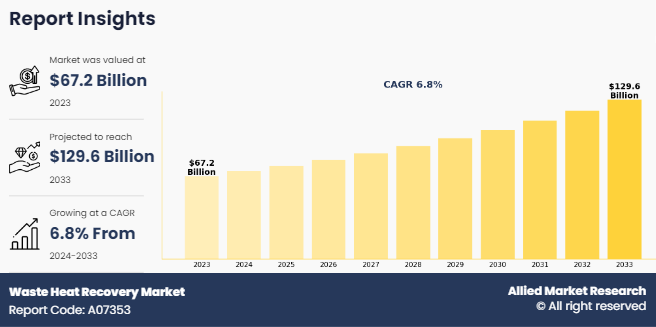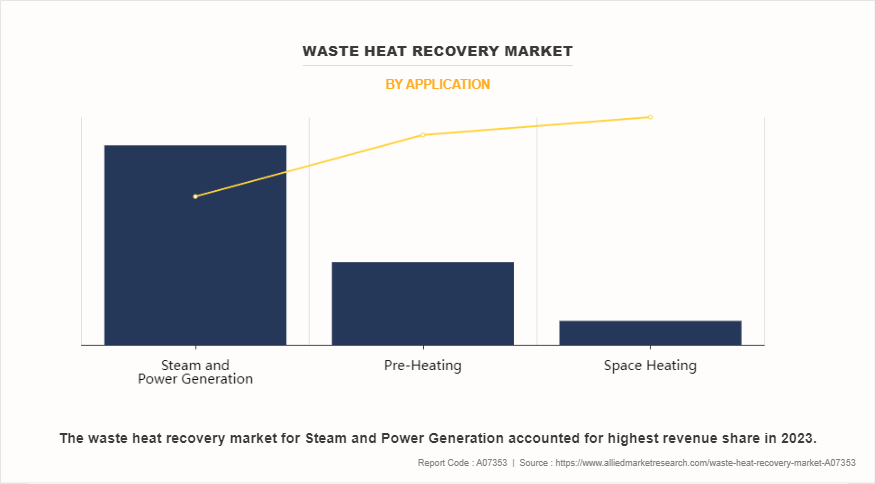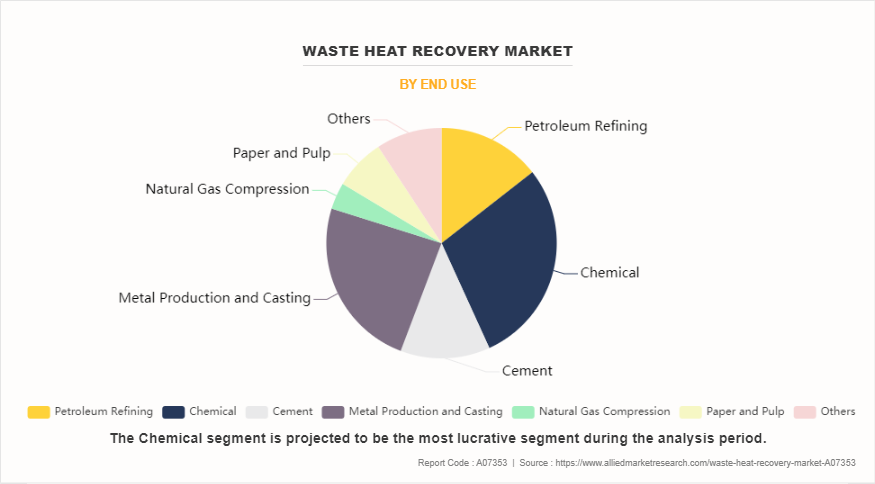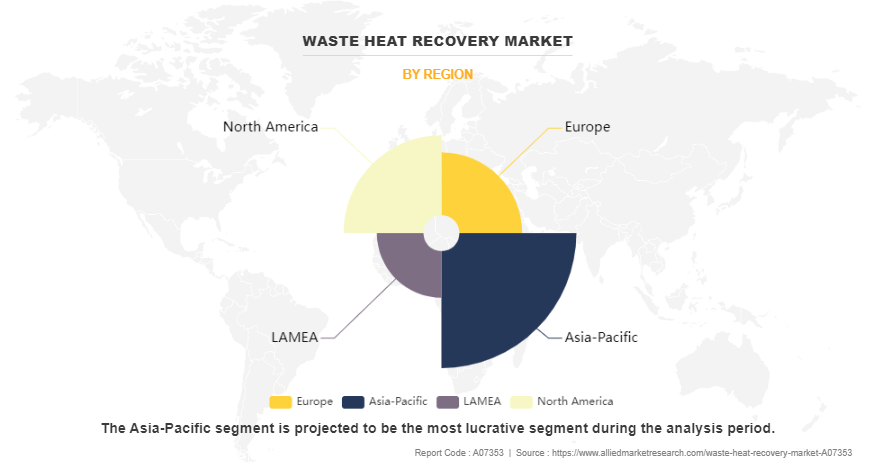Waste Heat Recovery Market Research, 2033
The global waste heat recovery market size was valued at $67.2 billion in 2023, and is projected to reach $129.6 billion by 2033, growing at a CAGR of 6.8% from 2024 to 2033.

Introduction
Waste heat recovery system involves capturing and reusing thermal energy which is lost in industrial processes or power generation. This process helps improve overall energy efficiency by converting waste heat into useful energy, such as electricity or hot water. Waste heat is recovered from various sources, including exhaust gases, hot liquids, or surfaces, and then used for different applications such as heating, cooling, or generating power.
Key Takeaways
- The global waste heat recovery market has been analyzed in terms of value ($Billion). The analysis in the report is provided on the basis of application and end use, 4 major regions, and more than 15 countries.
- The global waste heat recovery industry report includes a detailed study covering underlying factors influencing industry opportunities and trends.
- The key players in the waste heat recovery market are ABB Ltd., Mitsubishi Heavy Industries Ltd, TLV CO., LTD, Thermax Ltd, Siemens AG, Robert Bosch GmbH, General Electric Company, Echogen Power System, Schneider Electric SE, and Kawasaki Heavy Industries, Ltd.
- The report facilitates strategy planning and industry dynamics to enhance decision making for existing market players and new entrants entering the alternators industry.
- Countries such as China, the U.S., Canada, Germany, and Brazil hold a significant share in the global waste heat recovery market.
Market Dynamics
The increase in focus on carbon emission reduction is significantly driving the demand for waste heat recovery technologies. As governments and organizations globally strive to meet stringent climate goals and reduce greenhouse gas emissions, there is a growing emphasis on enhancing energy efficiency across various industrial sectors. Waste heat recovery systems offer a practical solution by capturing and reusing the excess heat generated during industrial processes, which is lost to the environment. According to World Resources Institute emphasizes the need to peak greenhouse gas (GHG) emissions before 2025, nearly halve them by 2030, and reach net-zero CO2 emissions around mid-century to avoid the most severe impacts of climate change. All these factors are expected to drive the demand for the waste heat recovery market forecast.
However, the initial expenditure on waste heat recovery systems represents a considerable financial commitment, which is a deterrent despite the potential for significant long-term savings and efficiency gains. The need for specialized equipment and the complexity of integrating these systems into existing infrastructure further adds to the financial burden. In cases where the return on investment (ROI) is not immediate hence businesses are reluctant to make the initial investment. All these factors hamper waste heat recovery market growth.
The integration of smart technologies, such as IoT sensors and advanced control systems, is enhancing the performance and efficiency of WHR systems. These technologies enable real-time monitoring and optimization of heat recovery processes, ensuring that energy is captured and reused with maximum efficiency. This increases the economic viability of WHR projects and makes them more adaptable to varying industrial conditions. In addition, modular and scalable WHR solutions are becoming more prevalent, allowing businesses to tailor systems to their specific needs and gradually expand their capacity as their operations grow. These innovations reduce the complexity and cost of implementing WHR systems, making them more attractive to a broader range of industries. All these factors are anticipated to offer new growth opportunities for the global waste heat recovery market.
Segments Overview
The waste heat recovery market is segmented into application, end use and region. On the basis of application, the market is classified into steam and power generation, pre-heating, and space heating. By end use, the market is segmented into petroleum refining, chemical, cement, metal production and casting, natural gas compression, paper and pulp, and others. Region-wise, the market is analyzed across North America, Europe, Asia-Pacific and LAMEA.

On the basis of application, the market is classified into steam and power generation, pre-heating, and space heating. The steam and power generation segment accounted for less than two-thirds of the waste heat recovery market share in 2023 and is expected to maintain its dominance during the forecast period. Environmental regulations and sustainability goals drive the adoption of WHR systems for steam and power generation. Many governments around the world, including those in the U.S., Europe, and China, have implemented stringent emissions and energy-efficiency regulations. In addition, the rise in focus on sustainability and the shift toward a circular economy motivate industries to integrate energy-saving technologies that contribute to reduced carbon footprints.

By end use, the market is segmented into petroleum refining, chemical, cement, metal production and casting, natural gas compression, paper and pulp, and others. The chemical segment accounted for less than one-third of the waste heat recovery market share in 2023 and is expected to maintain its dominance during the forecast period. The chemical industry is highly energy-intensive, with significant energy losses occurring through heat dissipation during various processes such as distillation, cracking, and reaction processes. By implementing WHR systems, companies recover and reuse this lost energy, significantly reducing fuel consumption. This leads to lower operational costs, improving profitability. The recovered heat is used to pre-heat feedstocks, generate steam, or drive turbines for power generation, further reducing the demand for external energy sources.

Region-wise, the market is analyzed across North America, Europe, Asia-Pacific and LAMEA. The Asia-Pacific region accounted for less than two-fifth of the waste heat recovery market share in 2023 and is expected to maintain its dominance during the forecast period. Government policies and energy efficiency regulations play a significant role in the adoption of waste heat recovery systems across the region. Several Asia-Pacific nations, such as China, Japan, South Korea, and India, have set ambitious energy efficiency and carbon reduction targets. China, for instance, has incorporated WHR technologies into its five-year plans, aiming to reduce industrial emissions and improve energy security. The government's financial incentives, coupled with stricter regulations on industrial emissions, are encouraging the installation of WHR systems in energy-intensive industries such as steel, cement, and chemicals
Competitive Analysis
Key players in the global waste heat recovery market overview include ABB Ltd., Mitsubishi Heavy Industries Ltd, TLV CO., LTD, Thermax Ltd, Siemens AG, Robert Bosch GmbH, General Electric Company, Echogen Power System, Schneider Electric SE, and Kawasaki Heavy Industries, Ltd.
Key Benefits For Stakeholders
- This report provides a quantitative analysis of the waste heat recovery market statistics, segments, current trends, estimations, and dynamics of the waste heat recovery market analysis from 2023 to 2033 to identify the prevailing waste heat recovery market opportunities.
- The market research is offered along with information related to key drivers, restraints, and opportunities.
- Porter's five forces analysis highlights the potency of buyers and suppliers to enable stakeholders make profit-oriented business decisions and strengthen their supplier-buyer network.
- In-depth analysis of the waste heat recovery market segmentation assists to determine the prevailing market opportunities.
- Major countries in each region are mapped according to their revenue contribution to the global waste heat recovery market report.
- Market player positioning facilitates benchmarking and provides a clear understanding of the present position of the market players.
- The report includes the analysis of the regional as well as global waste heat recovery market trends, key players, market segments, application areas, and market growth strategies.
Waste Heat Recovery Market Report Highlights
| Aspects | Details |
| Market Size By 2033 | USD 129.6 billion |
| Growth Rate | CAGR of 6.8% |
| Forecast period | 2023 - 2033 |
| Report Pages | 296 |
| By Application |
|
| By End Use |
|
| By Region |
|
| Key Market Players | Siemens AG, TLV CO., LTD, Schneider Electric SE., Kawasaki Heavy Industries, Ltd., Robert Bosch GmbH, Mitsubishi Heavy Industries Ltd., Thermax Limited, General Electric Company, ABB Ltd., Echogen Power Systems |
Analyst Review
According to the opinions of various CXOs of leading companies, the waste heat recovery market is expected to witness an increase in demand during the forecast period. Cost reduction and economic benefits and an increase in focus on carbon emission reduction have increased the demand for waste heat recovery during the forecast period. The growing emphasis on cost reduction and economic efficiency has significantly heightened the demand for waste heat recovery systems. By capturing and repurposing excess heat these systems help businesses and industries lower their energy expenses. This reduces operational costs and extends the lifespan of equipment by minimizing the need for additional fuel consumption. As a result, companies achieve substantial savings on energy bills and improve their overall financial performance.
In addition to economic benefits, there is an increase in focus on reducing carbon emissions and minimizing environmental impact. Waste heat recovery plays a crucial role in this context by enhancing energy efficiency and reducing the reliance on fossil fuels. By converting waste heat into useful energy, these systems help lower greenhouse gas emissions, aligning with global sustainability goals and regulatory requirements. This dual advantage of cost savings and environmental benefits makes waste heat recovery a preferable solution for industries aiming to optimize their operations while contributing to a greener future.
Cost reduction and economic benefits, Increase in focus on carbon emission reduction are the upcoming trends of waste heat recovery market in the world.
Steam and power generation is the leading application of Waste Heat Recovery Market
Asia-Pacific is the largest regional market for Waste Heat Recovery
$129.6 billion is the estimated industry size of Waste Heat Recovery by 2033.
Key players in the global waste heat recovery market include ABB Ltd., Mitsubishi Heavy Industries Ltd, TLV CO., LTD, Thermax Ltd, Siemens AG, Robert Bosch GmbH, General Electric Company, Echogen Power System, Schneider Electric SE, and Kawasaki Heavy Industries, Ltd are the top companies to hold the market share in Waste Heat Recovery
Loading Table Of Content...
Loading Research Methodology...


